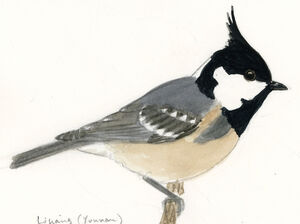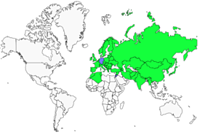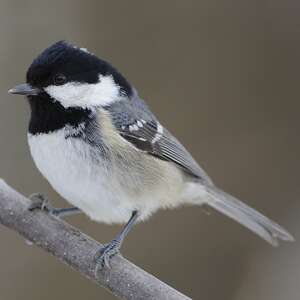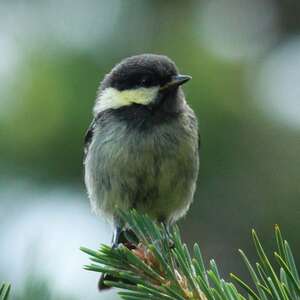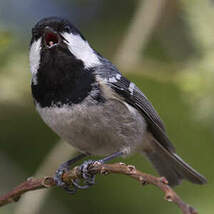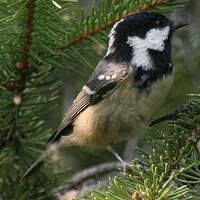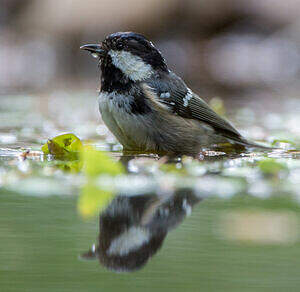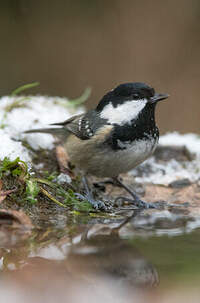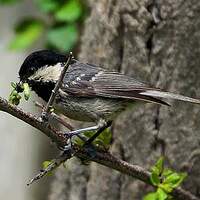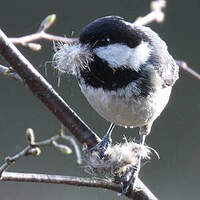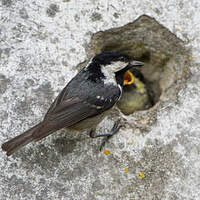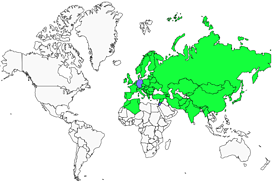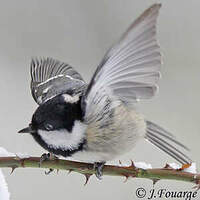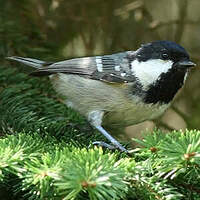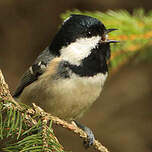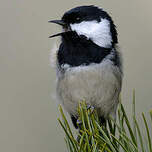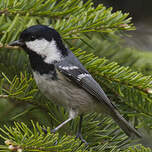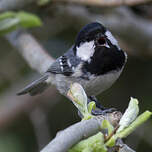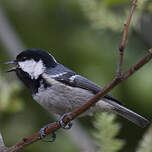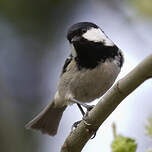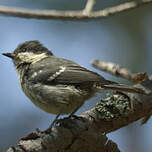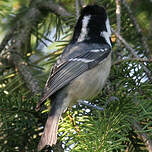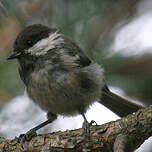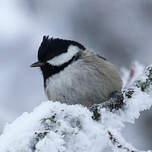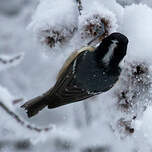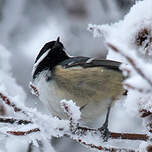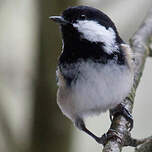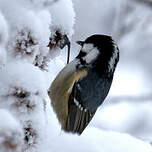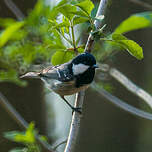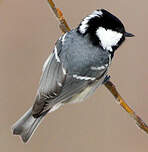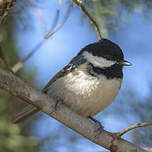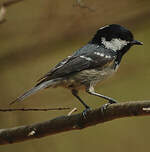Coal Tit
Periparus ater - Mésange noire
Identification
Here we will describe the subspecies ater which occupies the western part of the continent. At first glance, the Coal Tit resembles the Coal Tit. A first examination, however, reveals the differences. It is already smaller. Its plumage is devoid of yellow (except in the juvenile whose white parts are tinged with yellow). The head is black with three white zones, two on the sides and one on the neck. The upper body is gray, slightly tinged with blue. Wings and tail are gray. On the wings, there are two white bars due to the white tips of the medium and large coverts. The underside of the body is whitish gray with the upper chest black in connection with the black throat and the under tail slightly lighter. The flanks are tinged with fawn. The sexes are almost identical. The male is distinguished by its brighter, brighter colors. His black chin is more consistent. The female is a bit drabber, with the beard less well marked. The juvenile is even duller than the female, with the head slightly obscured, the white tinged with yellow and an absence of blue tone on top. His beard is poorly defined. The yellow hue that invades the clear parts of its plumage will disappear with wear. All the other subspecies have the lower parts more reddish, even the ssp vieirae of the neighboring Iberian Peninsula which has the top without blue shade and the underside clearly more tinged with brown-red.
Subspecific information 21 subspecies
- Periparus ater ater (Continental Europe and Asia Minor through Siberia to Kamchatka, Sakhalin Is., Korea, ne China and ne Mongolia)
- Periparus ater britannicus (Great Britain and ne Ireland)
- Periparus ater hibernicus (Ireland. except ne.)
- Periparus ater vieirae (Iberian Pen.)
- Periparus ater sardus (Corsica and Sardinia)
- Periparus ater atlas (Morocco)
- Periparus ater ledouci (n Algeria and n Tunisia)
- Periparus ater cypriotes (Cyprus)
- Periparus ater moltchanovi (s Crimean Pen.)
- Periparus ater michalowskii (Caucasus. except sw. and c and e Transcaucasia)
- Periparus ater derjugini (ne Turkey to sw Caucasus)
- Periparus ater eckodedicatus (w China)
- Periparus ater phaeonotus (se Azerbaijan, n Iran, sw Turkmenistan. ? winter visitor to sw Iran)
- Periparus ater rufipectus (se Kazakhstan to nw China)
- Periparus ater martensi (Kali Gandaki area. c Nepal.)
- Periparus ater melanolophus (e Afghanistan and nw Pakistan to nw Himalayas)
- Periparus ater aemodius (e Himalayas to n Myanmar)
- Periparus ater pekinensis (ec China)
- Periparus ater insularis (s Kuril Is. and Japan)
- Periparus ater kuatunensis (se China)
- Periparus ater ptilosus (Taiwan)
Foreign names
- Mésange noire,
- Carbonero garrapinos,
- chapim-carvoeiro,
- Tannenmeise,
- fenyvescinege,
- Zwarte Mees,
- Cincia mora,
- svartmes,
- Svartmeis,
- sýkorka uhliarka,
- sýkora uhelníček,
- Sortmejse,
- kuusitiainen,
- mallerenga petita,
- Barrmeisa,
- sosnówka,
- meža zīlīte,
- menišček,
- Московка,
- ヒガラ,
- 煤山雀,
- 煤山雀,
Voice song and cries
The call is a tji or tju or even tiuh often preceded by a sih, giving a typical si tiuh sound to the ear. The song is fairly loud and bisyllabic: Titjut titjut titjut, or pitsi pitsi pitsi or something else, even three notes such as siTuit siTuit siTuit. A particular tone identifies the species as the Coal Tit.
Habitat
The Coal Tit is typically a resident of coniferous forests, spruce forests, pine woods and fir woods.
Behaviour character trait
This active bird, seeming tireless, is sometimes familiar and confident, sometimes shy. It lives alone or in pairs during the breeding season. The rest of the year, the Coal Tits group together in bands of up to 50 individuals, but sometimes groups of several hundred birds can be observed. They rest alone under drooping branches, in old nests, in ivy thickets, in holes and crevices. They sometimes dig cavities to rest in rotting stumps. Coal Tits usually search for their food at the top of conifers, using their adapted beak to open cones or to grasp in the middle of conifer needles.
They also regularly prospect the ground, especially during the winter period. This is particularly evident in Britain and Western Europe, regions where the absence of snow cover facilitates access to fallen fruits, beeches, spruces... From June to December, Coal Tits constitute larders. They store food in the upper part of trees, in hollowed out places, under a cluster of needles, but also under tufts of lichens, in bark cracks and on the ground. Access to these reserves allows tits to overcome periods of famine. In winter, northern populations migrate south, sometimes in such great numbers that one can speak of invasion. Some reach the Iberian Peninsula and the west of the Mediterranean region, but most do not go further than Central and Western Europe. Those who have chosen sedentarism suffer from cold and lack of food. They find their food with difficulty, the snow accumulated in layers on the branches or the formation of ice prohibiting access to the bark of trees or spruce needles.As the winter diet of the Coal Tit consists largely of the seeds from Norway Spruce, Silver Firs, Aleppo Pines or Beech Trees, mortality can often be quite high.Dietfeeding habits
Reproduction nesting
In the Western Palearctic, nesting takes place from April to the end of July. In the Himalaya, it appears to take place from April to June.
As with most tits, the Coal Tit nests in tree holes, walls, or terrestrial cavities. However, conifer forests do not offer as many possibilities as deciduous forests. Apart from natural tree cavities, they will make do with a crevice in a rock, a gap between roots, or a small rodent burrow, and they also nest in the attics of forest cabins. It is evident that these nests, especially those built on the ground, are often destroyed, either directly by natural predators or by flooding resulting from heavy rains. The couples nest regularly twice per summer. The nest is well lined with moss and animal fur, and the female is in charge of creating and furnishing the nest as well as incubating the 8 to 10 eggs. These eggs are similar to those of other tits, and incubation takes 14 to 15 days. Feeding takes 16 to 17 days, but even after the chicks have left the nest, the parents continue to feed them for some time.Geographic range
The Coal Tit is common from the European Atlantic coast to the Pacific coast (Kamtchatka, Komandorski Islands, Japan and Taiwan). To the north, it can be found up to the limit of forested areas. The most northerly region is the Mourmansk region in Russia (ssp. ater). To the southern limit, it is found in the Maghreb (ssp. atlas and ledouci), Turkey (ssp. ater and djerjugini), the north of Iran (ssp. phaeonotus), the Himalayas and the hills of southern China (ssp. melanolophus, rufipectus, aemodius and kuatunensis). The southernmost point is Taiwan Island (ssp. ptilosus). This shows the great intraspecific diversity (19 spp).
Threats - protection
Sources of information
- IOC World Bird List (v13.2), Gill, F and D Donsker (Eds). 2023.
Other sources of interest
 Specification sheet created on
28/10/2023 by Didier Collin
Specification sheet created on
28/10/2023 by Didier Collin partially rewritten on 00/00/0000 by Jean François
Translation by AI Oiseaux.net
published: 07-11-2002 - Updated: 15-02-2023
© 1996-2024 Oiseaux.net
- Accipitriformes
- Aegotheliformes
- Anseriformes
- Apodiformes
- Apterygiformes
- Bucerotiformes
- Caprimulgiformes
- Cariamiformes
- Casuariiformes
- Charadriiformes
- Ciconiiformes
- Coliiformes
- Columbiformes
- Coraciiformes
- Cuculiformes
- Eurypygiformes
- Falconiformes
- Galliformes
- Gaviiformes
- Gruiformes
- Leptosomiformes
- Mesitornithiformes
- Musophagiformes
- Nyctibiiformes
- Opisthocomiformes
- Otidiformes
- Passeriformes
- Pelecaniformes
- Phaethontiformes
- Phoenicopteriformes
- Piciformes
- Podargiformes
- Podicipediformes
- Procellariiformes
- Psittaciformes
- Pterocliformes
- Rheiformes
- Sphenisciformes
- Steatornithiformes
- Strigiformes
- Struthioniformes
- Suliformes
- Tinamiformes
- Trogoniformes

